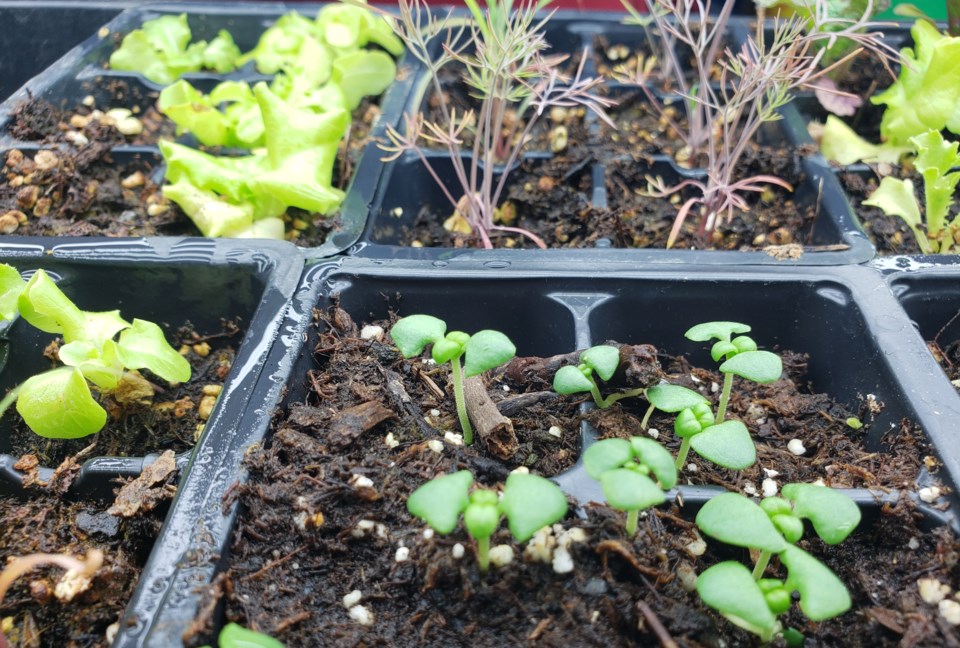One of the most wondrous things about being a gardener is starting seeds. It is also a good remedy on how you can effectively shorten winter. As it is now March, it is time to get serious about what to grow so you are ready for spring.
Growing your own plants from seed allows us freedom to grow almost anything we desire. There is an amazing selection of different varieties and cultivars of plants that sometimes makes it rather difficult for us to decide what we should grow. It is easy to get carried away and grow too much as at this time of year we are craving green growth and those tiny little packets don’t seem to hold that much. It is only once those plants get growing, we see how a few seeds can easily grow into way too many plants. Instead of planting all the seeds in the package, plant only as many as you will need. Share the leftovers or store them in a cool, dry place.
As far as equipment goes – you certainly do not need too much to supply the essentials of plant life. They need light, water, warmth, oxygen and food to grow and for the beginning of life we do not even need to fertilize. You do not need any special containers as long as whatever you are using has drainage. I like to use small vessels when starting seeds, but really anything will work. Years ago, when I was growing dried flowers, I started thousands of plants in tiny one-use cardboard drinking cups because I had a large supply and there was not a lot of dollars to spend frivolously.
I like to use a sterilized soilless media to start my seeds as I always have some of that on hand. For seeds that are sensitive to bacterial or fungal issues, perlite or vermiculite also works well. I sow the seeds into the media, cover with a plastic film or tray cover and place the seeds in a warm place. Unless you are growing seeds that need specialized conditions for germination, just keep the trays in a warm location. Over the years I have experimented with may different methods – but really it is best to keep it simple. I sow the seeds in media that is moistened with hot water, cover and leave them under lights 24 hours a day until they sprout. The seedlings should have the cover removed gradually to adjust them to a lower humidity. I like using plastic wrap as you can uncover a row or two at a time as all seeds will not germinate at the same speed.
When choosing what to grow, it is easiest to start by growing those plants that are relatively easy to germinate and do not need special conditions. Most seed packages will give directions on how to plant those specific seeds. Generally, small seeds need not be covered with soil but instead gently pressed into the media or soil. Medium seeds can be lightly covered and large seeds can be poked right into the soil. A good rule of thumb is to plant the seed to the depth of their diameter.
The timing of the planting is important as well. Count backwards from the time you can safely plant into the garden and sow the seeds according to that schedule. A general good rule of thumb for much that we commonly grow is to plant about 8 to 10 weeks prior to the last spring frost, but consider the time to germination of each seed as well.
Once the seeds germinate those young seedlings will need adequate light in order to grow. Placing them directly under a fluorescent light fixture or grow light will ensure that the seedlings are strong and sturdy. If you find that your seedlings are tall and spindly it is because they are not getting enough light and are reaching for the sun. When the seedlings have their third true leaf, they are ready for transplanting. A light air flow over the seedlings using a fan will help them to grow up to be sturdy plants – but be careful that you are paying attention to the watering. They need to be kept evenly moist but never soggy.
Hanbidge is the lead horticulturist with Orchid Horticulture. Find us at ; by email at [email protected]; on facebook @orchidhort and on instagram at #orchidhort.
Tune into GROW Live, weekly on our Facebook page or check out the Youtube channel GROW




